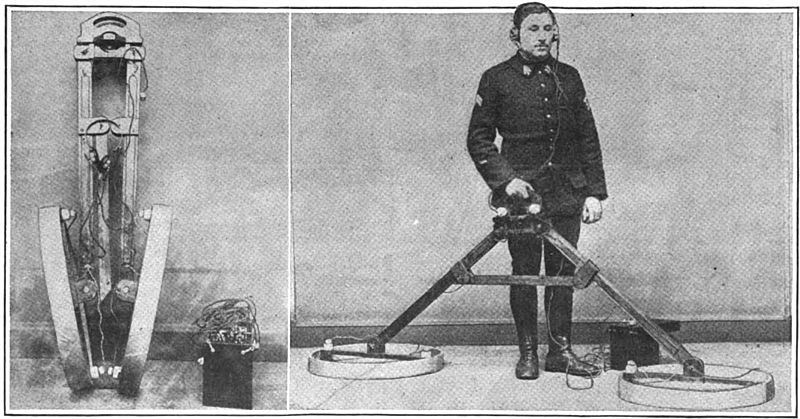Image: Metal detector from World War 1

Description: An early experimental metal detector used for finding unexploded bombs in post World War 1 France. Named the "Alpha", it was designed by M. Guitton, professor of physics at Nancy. It used the principle of the "Hughes inductive balance" circuit invented by British scientist David Hughes in 1879. Each of the two separate coils mounted on the frame is a double coil or transformer, with the primary winding attached to a source of audio alternating current. The secondaries are wired in series with opposing phase to the operator's earphones. As long as there is no metal in range of the magnetic fields of the coils, the currents induced in the two secondary coils balance and cancel each other out, and no tone is heard. But if a piece of metal is in range, the eddy currents in it change the phase of the voltage induced in one of the secondaries, unbalancing the circuit, and a tone is heard. In use, the operator carried the frame around, sweeping the suspected area with the coils near the ground. An assistant followed, carrying the heavy control and battery box (box on ground). Both coils were sensitive, so when a signal was heard the operator had to determine by additional sweeps which coil the metal was near. The bulky instrument could fold up (left) for travelling. The device wasn't very sensitive compared to modern metal detectors; it could detect a 10 kg mass at a depth of 40 or 50 cm, and a smaller mass at a depth of 20 to 30 cm.
Title: Metal detector from World War 1
Credit: Downloaded September 1, 2013 from F. Honoré, "Locating unexploded shells on the battlefields of France" in Scientific American (Scientific American Publishing Co., New York), Vol. 120, No. 16, p. 395 on Google Books
Author: F. Honoré,
Usage Terms: Public domain
License: Public domain
Attribution Required?: No
Image usage
The following page links to this image:

